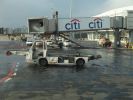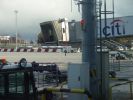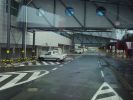



Once the aircraft stops at its designated stand, it's time to secure it so the passengers can deplane, more passengers can board, and so on. Usually, this happens at a stand near a terminal building that is connected to the airliner using a jet bridge (also called a jetway, an aerobridge, or a boarding bridge, and using a few more similar terms). You can see a few pictures of the bridge here. The first picture shows the driver's cabin (I will talk about that more later) at the right side of the open end, the last picture shows the bridges from the bottom.
The parking brake of an airliner has just been engaged and the engines are still running. The ground crew (airport or airline employees taking care of the aircraft when it's on the ground) will secure the wheels of the aircraft so it doesn't accidentally move. Aircraft of course needs electricity to power the on-board computers and other systems; while the engines are on, they generate electricity. But it would be ineffective and dangerous to leave the engines running all the time on the ground and the auxiliary power unit (pretty much a small engine in the back of the airliner) is noisy and expensive to keep it running for extended periods of time, so the ground crew will attach external power to the aircraft. You can see the external power cable in the previous set of pictures; it's the orange cable hanging from the side of the bridge. The aircraft engines are then shut down.
To speed up the process of handling the aircraft on the airport, the jet bridge is attached to the bridge when the engines are still shutting down. An operator, who sits in the front of the bridge, maneuvers it close to the aircraft; that's why it's so important to park the aircraft very precisely. Then the canopy is extended from the metal part of the bridge to provide a weather-proof connection to the aircraft. You can see different phases of the attachment on the next set of pictures.
Once the bridge is attached and the airliner door is opened, the passengers can deplane and the cleaning crew can make the airliner ready for the next set of passengers. Meanwhile, the baggage needs to be unloaded and the baggage of the new passengers loaded. In most aircraft, the baggage pieces are transported on the ground in special cars and they are loaded and unloaded onto / from the airliner one at a time using a conveyor belt (and a lot of muscle power). Some (a small percentage) of the new airliners use big containers to load load and unload all the baggage in one go. You can see the handling of baggage using the conveyor belts on the next set of pictures.
The next picture shows the folded conveyor belt and the last one displays the cars that transport the containers with baggage.
Most airlines except the low-cost ones serve meals, so they need to load the containers of food, as you can see on the next picture: the truck near the aft fuselage is the catering truck. Usually airlines subcontract a catering company that cooks the meals somewhere away from the airport and then transports whole containers with food for the whole flight directly to the airliner.
In the beginning of this chapter, I said that airplanes usually park at a stand very close to the terminal building. But what happens when a gate is not available (since each type of airliner can only connect to a specific type and size of the bridge) or when it's not possible to use it for some other reason (perhaps because the rent of the bridge is higher than the rent just of a stand on a location not very close to the terminal)? The aircraft will park at a different designated area, called a hardstand, and the procedure will be the same, except the passengers will need to use the airstairs and a bus instead of the bridge. I don't have any pictures of the airport bus unfortunately, but the tour guide told us that because they are so wide and so low, they are unable to drive on the usual roads; they can only travel on the roads on the airport that are specially designed for them.
A medium airliner capable of carrying a little more than a hundred passengers (think Boeing 737 or Airbus A319) usually spends about an hour at the airport from the moment of the touchdown to the takeoff, assuming the airline does not want to stay there longer because of the flight schedule. This is not much time, considering that it includes time for all the processes like taxiing to the gate, deplaning passengers, cleaning up the aircraft, unloading and loading baggage, refuelling, boarding other passengers, taxiing back to the runway and waiting for all the necessary clearances. Some airlines however demand faster handling times - especially low-cost airlines. Low-cost airlines tend to have a high airplane utilization, because their profit margins are not very high and because their airliners only make money when they are in the air carrying passengers. Low-cost airlines have the plane usually ready for the second leg of a trip 45 minutes after touching down, but this means that some tasks like cleaning the aircraft must be skipped and is only done every second or third leg. And the Dublin-based low-cost airline Ryanair, which recently announced to start flying to Prague, requested the handling times be cut down to half an hour.
Copyright notice: Text and images copyright by Michal Řeháček.